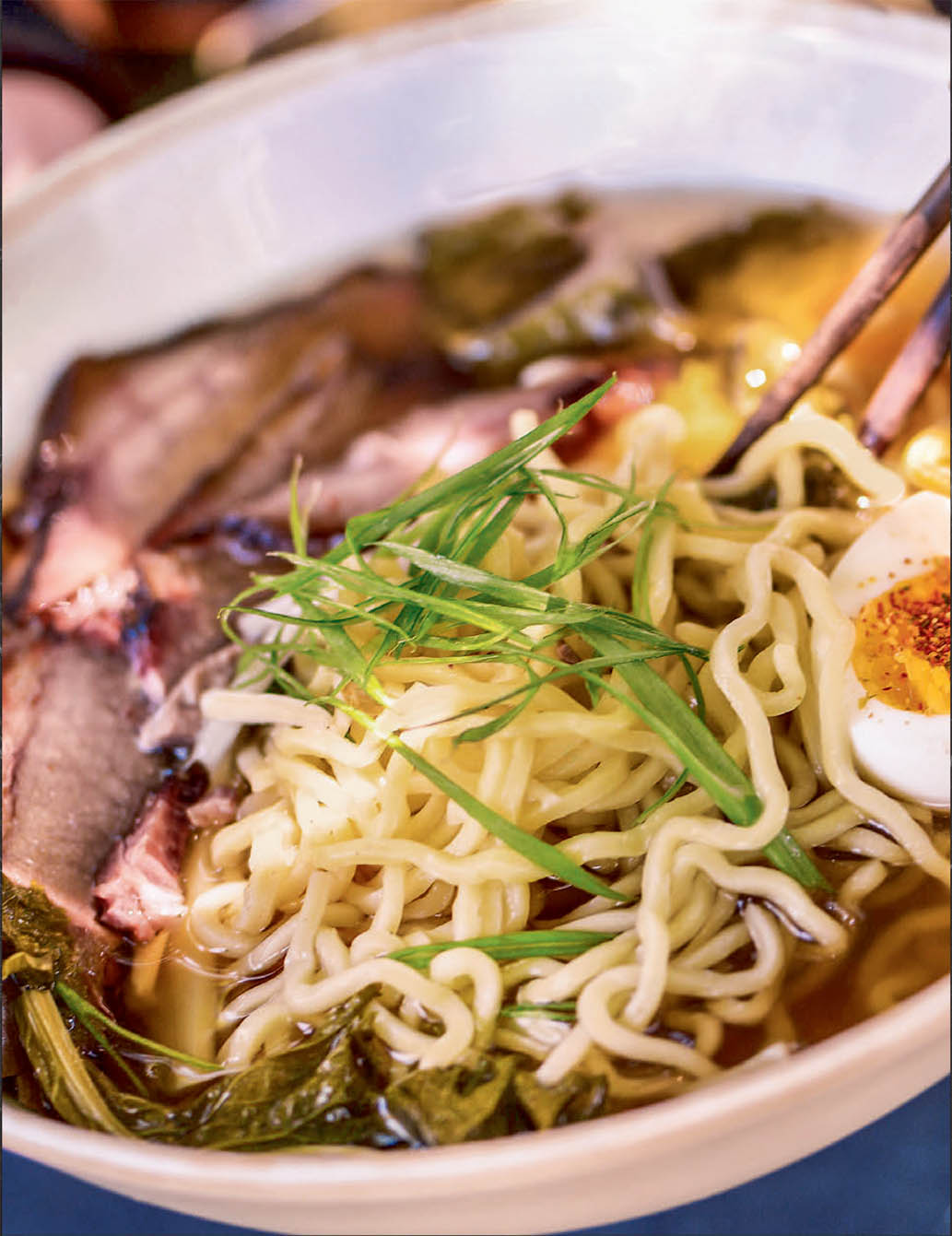

Chapter 5
BRISKET BOILED, STEWED, AND FRIED
When you think of high-adrenaline cooking methods—smoking, grilling, stir-frying—boiling probably never crosses your mind. After all, what could be less exciting than throwing meat and vegetables into a pot and simmering them into submission? Yet boiling produces three of the world’s most beloved brisket dishes: Italian bollito misto (boiled dinner), Vietnamese pho (beef noodle soup), and Spanish Caribbean ropa vieja (“old clothes,” literally)—shredded brisket in spicy Creole sauce. Without it, we wouldn’t have new school brisket ramen or Cuban vaca frita (literally “fried cow”). In this chapter, you’ll learn how to harness this seemingly primitive cooking method to create brisket dishes of surprising sophistication. So, haul out your stockpot: Brisket bliss will soon be bubbling up on your stove.

PHO FROM SCRATCH
(VIETNAMESE BRISKET RICE NOODLE SOUP)
YIELD: Serves 6 (can be multiplied as desired)
METHOD: Boiling
PREP TIME: 40 minutes
COOKING TIME: 3 hours, or as needed
HEAT SOURCE: Stove, charcoal or gas grill, or a broiler
YOU’LL ALSO NEED: 2 large stockpots; a fine-mesh strainer or chinois; cheesecloth; butcher’s string; a rimmed sheet pan
WHAT ELSE: I’m not going to minimize the time and effort that go into this pho. You’ll need two large stockpots and about 4 hours of prep work and simmering. Happily, the broth freezes well (and for that matter, so does the brisket). Here, you’ll find a recipe for Pho in a Hurry, but if you have the time, I urge you to try the real deal. It’s as soulful and complex as soup gets, with the added advantage of making your whole house smell terrific. Note: Rice sticks are noodles made from pureed cooked rice, ranging from ꠳ to ½ inch in width. (I prefer ¼-inch-wide noodles for this soup.) Look for rice sticks at Asian markets and in the ethnic foods section of most supermarkets.
“No talking when you eat pho,” says chef John Nguyen. “The worst sin is to let the soup get cold—even at the expense of conversation.” Born in Ho Chi Minh City and raised in “Little Vietnam” (Orange County, California), Nguyen is nothing if not serious about Vietnamese beef noodle soup. I met him at my favorite pho restaurant in New York City—Hà Nô˙i House on St. Marks Place in the East Village—where he presides over a waist-high stockpot. Brisket, oxtail, and marrow bones have been simmering for 16 hours (!) to make a broth that Nguyen fortifies with fistfuls of fire-charred ginger and onions.
Pho is served throughout Vietnam. According to Nguyen, the spiciest soup (bun bo hue) comes from the former imperial city of Hue in central Vietnam, where the broth is electrified with lemongrass, chiles, and shrimp paste. The Saigon version comes with sliced chiles, Thai basil, cilantro, and invigorating splashes of Vietnamese chile paste and hoisin sauce. But Nguyen prefers the classic simplicity of Hanoi-style pho. The high ratio of noodles and vegetables to meat makes pho a great dish for health-conscious eaters. “We keep the garnishes to a minimum,” Nguyen says. “The star of the show is the broth.”
INGREDIENTS
For the broth
3 to 3½ pounds brisket (preferably both flat and point)
1 pound oxtails, cut into 2-inch sections (optional—if you don’t use oxtails, increase the brisket to 4 pounds)
Vegetable oil, for oiling the grill grate
4 medium onions, unpeeled, cut in half lengthwise
2 pieces unpeeled ginger (each about 3 inches long), cut in half lengthwise
For the seasoning
5 whole star anise pods
3 cinnamon sticks, each about 3 inches long
2 tablespoons coriander seeds
1 tablespoon fennel seeds
6 whole cloves
½ cup Asian fish sauce (preferably Vietnamese, such as Red Boat brand), or to taste
½ cup packed dark or light brown sugar, or to taste
To finish the soup
1 pound dried rice sticks (rice noodles; see What Else)
1 red onion, peeled and very thinly sliced crosswise into rounds
4 scallions, trimmed, white and green parts thinly sliced crosswise
1 cup fresh cilantro leaves
Fried Shallot or Garlic Chips (optional; recipe follows)
1. Using a sharp knife, trim the brisket, leaving a layer of fat at least ¼ inch thick (see here). Be careful not to over-trim. It’s better to err on the side of too much fat than too little. Cut the brisket into 4 pieces, slicing it in half lengthwise (with the grain), then in half again widthwise.
2. Make the broth: Place the brisket pieces in a large stockpot with the oxtails, if using. Add cold water to cover by a depth of 6 inches. Bring the mixture to a rolling boil over medium-high heat and boil for 3 minutes, skimming the foam off the top with a ladle or large spoon. (You are blanching the meat to remove the impurities, which gives you a cleaner, clearer broth.) Drain the meat in a large colander and rinse it well with cold water. Wipe out the stockpot with a paper towel.
3. Return the blanched meats to the stockpot. Add 1 gallon of cold water or enough to cover the meat by a depth of 2 inches. Gradually bring the mixture to a gentle simmer over medium heat. Small bubbles should just break the surface throughout the cook; at no time after blanching the meats do you want a rolling boil. Skim the broth often with a ladle or large spoon to remove any fat or impurities that rise to the surface. Add water as needed to keep the meat covered.
4. Meanwhile, char the onions and ginger: Set up a grill for direct grilling (see here) and heat to medium-high. Brush and scrape the grill grate clean and oil it well. Arrange the onions and ginger, cut sides down, on the grate and cook until the surface is darkly browned, even charred, 3 to 5 minutes. (Alternatively, char the veggies under a hot broiler or in a dry cast-iron skillet over medium-high heat.) When they’re ready, add the onions and ginger to the broth. Cook for 1 hour, skimming occasionally.
5. Prepare the seasoning: Heat a dry skillet over medium-high heat. Add the star anise, cinnamon sticks, coriander seeds, fennel seeds, and cloves and roast until fragrant and toasted, 1 minute, stirring so the spices roast evenly. Tie the spices in a square of cheesecloth, or wrap them in aluminum foil that you perforate with a fork to release the flavor. Stir the spice bundle, fish sauce, and brown sugar into the broth.
6. Continue to simmer the broth until it is richly flavored and the brisket is very tender (but not so soft that it falls apart), another 2 to 2½ hours, or 3 to 3½ hours in all.
7. Using tongs, transfer the brisket and oxtails to a rimmed sheet pan and let them cool to room temperature, then cover with plastic wrap and refrigerate until well chilled.
8. Meanwhile, using a ladle and a strainer, strain the broth into another large stockpot. Correct the seasoning, adding more fish sauce and brown sugar to taste. The broth should strike an inviting balance between salty and sweet. (The broth can be prepared a day or so ahead to this stage.) Let it cool to room temperature, then cover and refrigerate.
9. Remove the chilled meat from the refrigerator and unwrap it. Use a meat slicer or sharp knife to cut the brisket across the grain into the thinnest possible slices. If using oxtails, pull the meat off the bones and shred it with your fingers into bite-size pieces. Set the meat aside.
10. Finish the soup: Remove any solidified fat from the top of the broth and discard. Reheat the broth in the stockpot over high heat; bring to a boil. While the broth reheats, fill a large bowl with cold water, add the rice noodles, and soak until soft and pliable, 15 to 30 minutes. Bring 3 quarts of water to a boil in another large pot. Just before serving, drain the soaked rice noodles in a colander and add to the boiling water. Boil the rice noodles until tender, 30 to 60 seconds. Do not overcook the noodles or they will become mushy. Strain the noodles in the colander.
11. To serve, use tongs to divide the warm noodles among 6 large soup bowls. Lay the brisket slices, oxtail bits, if using, and sliced red onion on top. Ladle in the hot broth (1½ to 2 cups per bowl). Sprinkle each serving of pho with sliced scallions, cilantro leaves, and fried shallot or garlic chips, if using. Serve the pho scalding hot—it must be scalding hot.

Hà Nô˙i House on St. Marks Place in New York City’s East Village
FRIED SHALLOT OR GARLIC CHIPS
Yield: Makes 1 cup
Fried shallots and/or garlic are traditional Southeast Asian garnishes and flavorings. The oil acquires a haunting flavor, too. Save it for drizzling over pho and other dishes.
INGREDIENTS
1½ cups vegetable oil
1 cup thinly sliced shallots or 12 cloves garlic, peeled and thinly sliced crosswise
1. Heat the oil in a heavy skillet over medium-high heat. Line a plate with paper towels. Dip a shallot slice into the oil: When bubbles dance, the oil is ready. (Or use a deep-fry thermometer: The oil should be 350°F.)
2. Add the shallots and fry, stirring so they color evenly, until golden brown, 2 minutes. Quickly transfer the fried shallots with a wire skimmer or slotted spoon to the prepared plate to drain. Use the shallots within minutes of frying.
Let the oil cool to room temperature, then store it in a sealed jar—use a spoonful or two for seasoning soups and salads. It will keep in the refrigerator for several days.
PHO IN A HURRY
YIELD: Serves 4 (can be multiplied as desired)
METHOD: Boiling
PREP TIME: 30 minutes
COOKING TIME: 20 minutes
HEAT SOURCE: Stove
YOU’LL ALSO NEED: A stockpot
WHAT ELSE: To make Pho in a Hurry, you’ll need cooked brisket. There’s no reason you can’t use leftover barbecued brisket (see here)—indeed, the resulting smoky flavor will take this traditional Vietnamese beef noodle soup into realms of gustatory wonder. Alternatively, you could use meat from the Jewish Deli Brisket recipe or from the Basic Brisket Broth recipe. As for broth, homemade is best, but a low-sodium store-bought brand will land a home run, too.
Okay, I know: The notion of pho in a hurry seems like a contradiction in terms. Doesn’t the broth take a half day to simmer, not to mention a special trip to your butcher to source the right meats? Yes, this classic Vietnamese beef noodle soup demands this and more, which is why pho is a dish more people enjoy at restaurants than at home. You purists out there will find the traditional made-from-scratch recipe. But if you happen to have some leftover brisket on hand or in your freezer (if you’re reading this book, I bet you do), you can make a comforting pho in a half hour. You get the same yin-yang of sweet spices and salty fish sauce, of meaty beef and chewy rice noodles—in a fraction of the time.
INGREDIENTS
For the pho
10 ounces rice sticks (see What Else)
8 cups Basic Brisket Broth (here) or beef broth or stock (preferably homemade or low-sodium)
3 whole cloves
6 thin slices unpeeled fresh ginger
3 whole star anise pods
3 cardamom pods (optional)
1 cinnamon stick, about 3 inches long, lightly crushed with a rolling pin
4 scallions, trimmed, white and green parts thinly sliced crosswise (keep separate)
2 to 3 tablespoons dark or light brown sugar, or to taste
2 to 3 tablespoons Asian fish sauce, or to taste
12 to 16 ounces cooked brisket (see What Else)
For serving
1 cup fresh mung bean sprouts
12 sprigs fresh Thai or regular basil
12 sprigs fresh cilantro
2 jalapeño or serrano chiles, stemmed and thinly sliced
2 limes, cut into wedges
For the dipping sauce
6 tablespoons hoisin sauce
6 tablespoons Vietnamese chile sauce, sambal oelek, or sriracha
1. Fill a large bowl with cold water, add the rice sticks, and soak until soft and pliable, 15 to 30 minutes.
2. Meanwhile, place the broth in a large stockpot. Stick the cloves in three of the ginger slices. Add the ginger, star anise, cardamom (if using), cinnamon, scallion whites, and 2 tablespoons each of the sugar and fish sauce. Simmer the broth over medium heat until richly flavored, about 15 minutes, adding more sugar or fish sauce as needed. The broth should be simultaneously sweet, salty, and aromatic. When the broth is ready, remove the ginger, star anise, cardamom, and cinnamon with a slotted spoon and discard.
3. Meanwhile, use a sharp knife to slice the brisket crosswise as thinly as possible. At restaurants, they do this on a meat slicer. If you have one, use it. (Thicker slices are okay, too, especially if you’re using leftover slices of barbecued brisket.) Arrange the mung bean sprouts, basil, cilantro, chiles, and limes on a platter.
4. Just before serving, bring the broth to a boil. Drain the soaked rice sticks in a colander, add them to the broth, and boil until tender, 30 to 60 seconds. Do not overcook the noodles or they will become mushy. Using tongs, transfer the rice noodles to large soup bowls. Arrange the brisket slices on top. Ladle the hot broth over the noodles and beef and sprinkle with the reserved scallion greens. Serve the vegetable and herb platter on the side.
5. Have each eater add bean sprouts, basil, cilantro, chiles, and lime juice to the soup as desired. Make a dipping sauce by mixing equal parts of the hoisin sauce and chile sauce in tiny bowls for each eater; use this as a dipping sauce for the brisket slices. Eat the solid ingredients with chopsticks and the broth with a spoon. It’s so satisfying that maybe next time you’ll be inspired to prepare the purist version.
THE JOY OF PHO
Everyone has a favorite comfort food, a dish you crave when you’re feeling underappreciated, under the weather, or simply overwhelmed.
For me, the ultimate restorative is pho (pronounced like “fur” without the “r” and with voice rising as for a question). There’s no cold so rheumy, no heartbreak so cruel, no hangover so ferocious, and no hunger so fierce that it can’t be relieved by a steaming bowl of this Vietnamese beef noodle soup.
Pho is Vietnam’s national dish—eaten for breakfast, lunch, dinner, and midnight snack (and just about any time in between) by people on all rungs of the socioeconomic ladder.
Which explains how I found myself in a pedicab, riding up the Avenue Pasteur in Ho Chi Minh City (formerly Saigon) under a blazing sun. We stopped at a nondescript storefront, where I made my way through a phalanx of beggars to one of the most famous noodle soup restaurants in Vietnam: Phỏ Hòa Pasteur.
Well, “restaurant” overstates it. Picture a tiny dining room crammed with Formica tables. Lime rinds and basil stems litter the floor. You don’t come here for the service. As for hygiene—well, when an eater finishes, he simply wipes his chopsticks clean with a basil leaf and returns them to a communal canister.
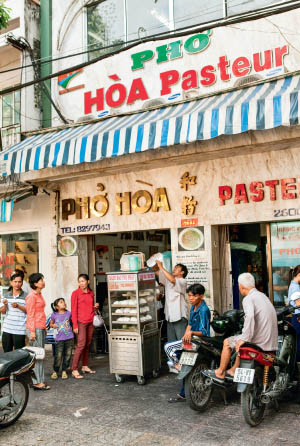
Phỏ Hòa Pasteur, Ho Chi Minh City
What you do come here for is the pho. Giant bowls of steaming broth laden with tangled skeins of rice noodles. The sweet scents of cinnamon and star anise mingle with the meaty aroma of long-simmered brisket and oxtail. The source of all these aromas is a mammoth cauldron in which tough but flavorful meats are boiled for hours into fork-tender (make that chopstick-tender) submission.
Pho may refer to a single soup, but there are myriad variations. Some people take their pho with thinly shaved beef tenderloin, so rare it’s almost mooing. Others—like me—prefer the richness of brisket boiled for the better part of a day. Accompanying the soup will be a platter of aromatic fresh Asian basil and cilantro, crisp bean sprouts, fiery chiles, and piquant lime wedges.
You’ll also be provided with a jar of dark sweet hoisin sauce and a squeeze bottle of Vietnamese chile sauce. Mix them together in the tiny bowls provided for this purpose to make a dipping sauce for the beef.
You don’t need to go to a proper restaurant to enjoy pho. Vietnam abounds with noodle stalls—casual eateries, where the cooking, eating, and washing up are done right on the sidewalk. The popularity of pho has given rise to a whole cottage industry—mi go, soup boys—who clack sticks together to attract customers. They’ll even deliver the soup to your apartment. Every evening, the streets of the city reverberate with the click-clack of their sticks.
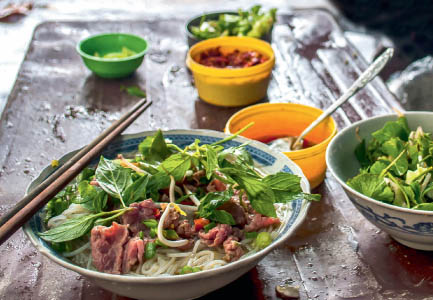
Sidewalk gourmet: Some of the best pho in Vietnam is served streetside.
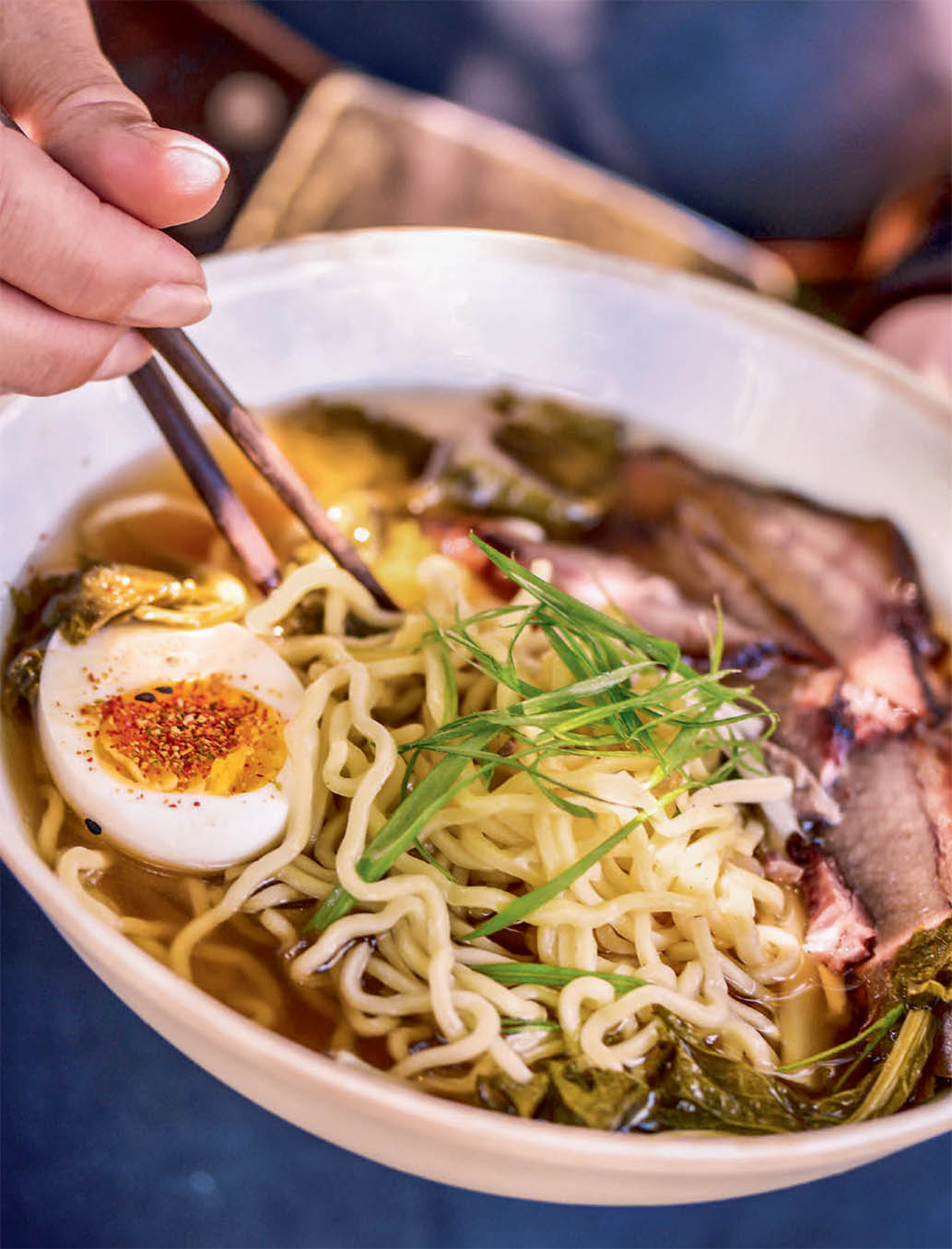
BRISKET RAMEN
YIELD: Serves 4
METHOD: Boiling
PREP TIME: 30 minutes
COOKING TIME: 30 minutes
HEAT SOURCE: Stove
YOU’LL ALSO NEED: A stockpot; a colander
WHAT ELSE: To be authentic, you’ll need some special ingredients. Kombu is Japanese dried kelp. Hon dashi is smoked, dried tuna broth (you’re going to use the powdered form—one good brand is Ajinomoto). Mirin is sweet rice wine. Bamboo shoots are available canned; pickled mustard greens come in jars. All are available at Japanese markets and stores like Whole Foods.
Call it globalization’s upside. Call it melting pot extreme. It’s what happens when American barbecue meets traditional ethnic cuisine. And it’s happening more and more across the country and around the world. Consider the brisket ramen (Japanese noodle soup) served at Kemuri Tatsu-ya in Austin, Texas. (The restaurant takes its name from the Japanese word for “smoke.”) Like all good ramen, it offers a complex interplay of flavors: the rich beefy broth, briny kelp, sweet mirin, creamy egg, crisp bean sprouts, pickled mustard greens, and, of course, chewy noodles. And lording over them all: the smoky awesomeness of Texas brisket. I’d be lying if I said the recipe is easy, but it does break down into a series of manageable steps. Also, you can omit or add various components based on time and availability. As long as you have noodles, brisket, and broth, you’ve got ramen.
INGREDIENTS
8 cups Basic Brisket Broth (here) or beef broth or stock (preferably homemade or low-sodium)
1 piece (2 by 3 inches) kombu (dried kelp)
1 tablespoon hon dashi powder
4 scallions, trimmed, white and green parts thinly sliced crosswise (keep separate)
3 tablespoons soy sauce, or to taste
3 tablespoons mirin, or to taste
1 tablespoon sugar, or to taste
1 tablespoon Brisket Butter, butter, or toasted (dark) sesame oil
To finish the soup
2 large eggs (preferably farm-fresh and organic)
1 can (8 ounces) bamboo shoots, drained
4 ounces fresh mung bean sprouts (optional)
12 ounces fresh ramen noodles (available at Asian markets)
12 to 16 ounces of your favorite barbecued brisket (see here), cut across the grain into ¼-inch-thick slices
8 ounces pickled mustard greens (see What Else)
1. Heat the brisket broth in a large stockpot over medium heat. Add the kombu and gently simmer to flavor the broth, 15 to 20 minutes. Remove the kombu and discard.
2. Stir in the hon dashi and scallion whites and simmer until the hon dashi dissolves, 2 minutes. Stir in the soy sauce, mirin, sugar, and Brisket Butter. The broth should be a little sweet and salty. Adjust the soy sauce, mirin, or sugar as needed. Keep the broth hot.
3. Prepare the garnishes: If using eggs, place them in a medium-size saucepan with cold water to cover. Gradually bring to a boil over medium-high heat. Boil the eggs for 7 minutes, then drain in a strainer and rinse with cold water. Shell the eggs under cold running water and set aside.
4. Thinly slice the bamboo shoots widthwise and rinse and drain in a strainer or colander. Rinse and drain the bean sprouts, if using.
5. Bring 3 quarts of water to a rolling boil in a large pot. Add the ramen and boil until just tender, 1 to 3 minutes. Drain the ramen in a strainer or colander.
6. To serve, divide the ramen among 4 large soup bowls. In each of the bowls, arrange the brisket slices in one quadrant on top. Cut the eggs in half lengthwise and place a half egg, yolk side up, in each of the second quadrants. Add the bamboo shoots and pickled mustard greens to the third quadrants. Ladle hot broth into each bowl. If using the mung bean sprouts, place them in the fourth quadrant of each bowl and sprinkle the scallion greens over all. Serve the ramen with chopsticks and Asian-style soup spoons.
BOLLITO MISTO
TWO BRISKETS AND A BIRD BOILED IN THE STYLE OF THE PIEMONTE
YIELD: Serves 8 with leftovers (and you’ll definitely want leftovers)
METHOD: Boiling
PREP TIME: 30 minutes
COOKING TIME: 3 hours, or as needed
HEAT SOURCE: Stove
YOU’LL ALSO NEED: A stockpot; cheesecloth; butcher string; a welled cutting board
WHAT ELSE: Bollito misto is about the easiest dish you’ll ever make: You stick everything in a pot and boil it. But proper sequencing is required so all the meats are ready at the same time. One way to do this is to stagger adding the meats to the broth. The other is to start all at once, removing each when it’s ready and reheating the ensemble in the broth at the last minute. I prefer the first method here, but both techniques work great. Piemontese tradition accords scant respect to the vegetables, which are added at the beginning solely to flavor the broth. I like to add more vegetables toward the end, so as to serve them alongside the meat rather than cooking them to mush; I’ve made this optional. Note: Cotechino is a soft garlicky Italian pork sausage. If unavailable, substitute another favorite fresh Italian sausage.
Meat boiled with root vegetables scarcely sounds like the stuff of epicurean reverie. Unless you come from the Piemonte in northern Italy, where you’ll recognize it as bollito misto (“mixed boil”) and you’ll salivate at its mere mention. The meats in this version are two types of brisket (beef and veal), their flavor augmented with a farm chicken and cotechino sausage. (The traditional version also contains tongue.) Italians fetishize the dish to the point of serving bollito misto at fancy restaurants from gleaming silver trolleys designed expressly for that purpose. The meats are sliced with ceremony and moistened with broth and salsa verde (a piquant green sauce of parsley, capers, and anchovies). Bollito misto belongs to a venerable family of boiled dinners that include French pot au feu, German Eintopf, and, of course, New England boiled dinner. It definitely deserves a place in your brisket repertory.
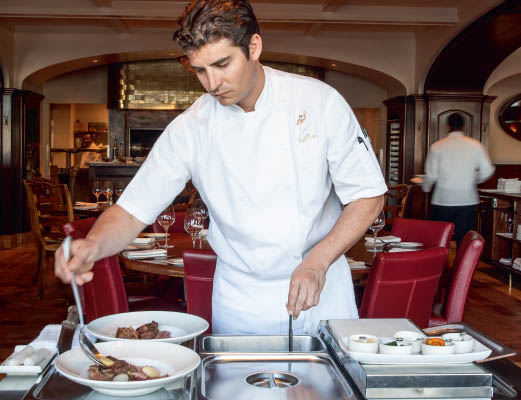
Serving bollito misto at a restaurant involves great ceremony.
INGREDIENTS
For the broth
1 dried bay leaf
1 medium white onion, peeled and quartered
1 whole clove
2 large carrots, peeled, trimmed, and cut into 2-inch chunks
2 ribs celery, scrubbed and cut into 2-inch sections
1 head garlic, skins intact, cut in half widthwise
4 large Roma tomatoes, halved and seeded (squeeze the halves to wring out the seeds)
2 large sprigs fresh rosemary, plus 3 tablespoons finely chopped rosemary needles for serving
2 tablespoons sea salt, or to taste
2 gallons cold water
2 tablespoons whole black peppercorns
1 tablespoon coriander seeds
For the meats and vegetables
1 beef brisket flat (3 pounds), trimmed (see here)
1 veal brisket flat (2 pounds, see Note), trimmed (see here)
1 small skin-on chicken (3 to 3½ pounds)
8 carrots, trimmed and peeled
8 ribs celery, trimmed and washed
2 medium turnips, trimmed, scrubbed, and quartered
1 pound baby onions, trimmed and peeled (optional)
1 pound cotechino or other fresh Italian pork sausage
Sea salt and freshly ground black pepper
Salsa Verde (recipe follows), for serving
1. Make the broth: Pin the bay leaf to one of the onion quarters with a clove. Place the onion quarters, carrots, celery, garlic, tomatoes, rosemary sprigs, and salt in a large stockpot and add the water. Tie the peppercorns and coriander seeds in a piece of cheesecloth (alternatively, wrap them in a piece of aluminum foil, poking holes in the resulting bundle with a fork to release the flavor). Add the spice bundle to the pot.
2. Add the beef brisket and bring to a boil over medium-high heat. Boil for 3 minutes, skimming off and discarding any foam that rises to the surface with a ladle.
3. Lower the heat and gently simmer the brisket, uncovered, for 1 hour. Skim the broth often to remove any foam or fat that rises to the surface. (Conscientious skimming is essential to a clean, clear broth.)
4. Add the veal brisket and simmer for 1 hour more, skimming the broth often.
5. Add the chicken and simmer for 30 minutes. Add the carrots, celery, turnips, baby onions (if using), and the cotechino or other sausage, and continue to simmer, skimming often, for 30 to 60 minutes more, about 3 hours in all.
6. At this point, both briskets and the chicken should be very tender. Lift the meats one by one out of the pot with tongs, drain well, and transfer to a welled cutting board. Cut the briskets across the grain into ¼-inch-thick slices. Arrange them on a large warm platter. Carve the chicken into 8 pieces and arrange on the platter. Slice the sausage into 8 equal pieces and arrange on the platter next to the chicken. Transfer the vegetables with a slotted spoon to the platter, placing them beside the sausage. Re-season the broth, adding salt and pepper to taste.
7. Serve the bollito misto with hot broth ladled over the meat and vegetables to moisten them, and additional broth in soup bowls on the side. Pass the Salsa Verde at the table.
Note: If you cannot find a veal brisket flat, substitute a beef brisket flat and add it in step 2, when you add the other beef brisket. In step 4, simply continue to simmer and skim the broth as directed.
(PARSLEY CAPER SAUCE)
Yield: Makes 2 cups
Think of this “green sauce” as Italian chimichurri. Brisket and other boiled meats electrify in its presence.
INGREDIENTS
1 bunch fresh flat-leaf parsley, stemmed
1 bunch fresh mint or basil, stemmed
4 oil-packed anchovy fillets, drained (optional)
2 tablespoons brined capers, drained
2 scallions, trimmed, white and green parts coarsely chopped
1 clove garlic, peeled and roughly chopped
1 teaspoon freshly grated lemon zest
3 tablespoons fresh lemon juice
2 tablespoons red wine vinegar
1 cup extra virgin olive oil
1 teaspoon hot red pepper flakes, plus extra as needed
Sea salt and freshly ground black pepper
Finely chop the parsley, mint, anchovies (if using), capers, scallions, garlic, and lemon zest in a food processor, running the machine in short bursts. Work in the lemon juice, vinegar, olive oil, hot red pepper flakes, and salt and pepper to taste—again, running the machine in short bursts. If the salsa is too thick, add a few tablespoons of water. Correct the seasoning, adding more salt, pepper, hot red pepper flakes, or lemon juice to taste. The salsa should be highly seasoned. The salsa is best made no more than an hour or two before serving. (Store it at room temperature.)
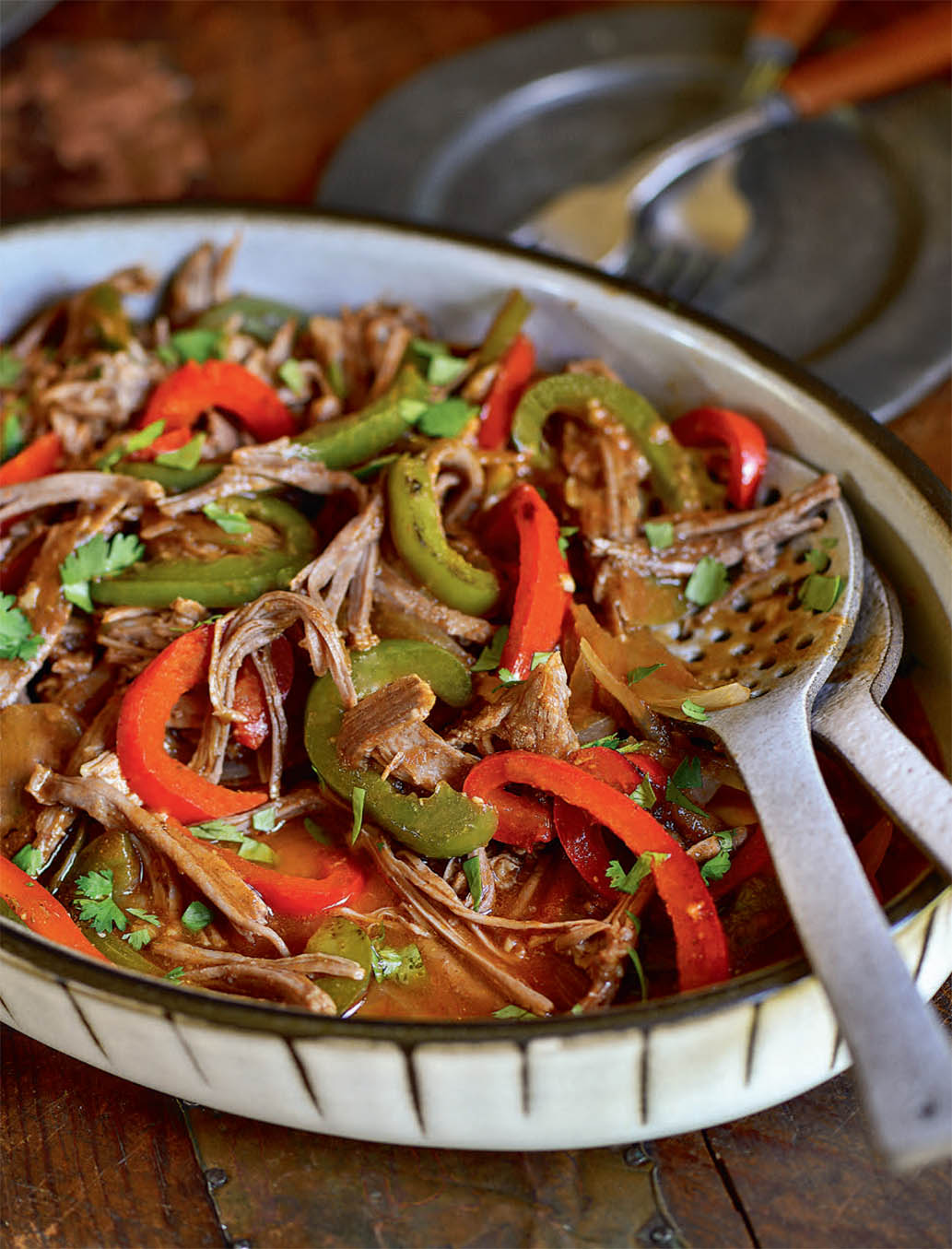
ROPA VIEJA (“OLD CLOTHES”)
“PULLED” BRISKET IN CREOLE SAUCE
YIELD: Serves 4
METHOD: Boiling, sautéing
PREP TIME: 30 minutes
COOKING TIME: 2½ to 3 hours for boiling the brisket, plus 15 minutes for the sauce
HEAT SOURCE: Stove
YOU’LL ALSO NEED: A stockpot; a baking dish; a strainer; a large skillet
WHAT ELSE: Ropa vieja requires a two-step cooking process: First you boil the brisket until tender, then you shred and sauté it in Creole sauce. So it requires a bit of time to make in one day (what else is new with brisket?) or advance planning so you can make it over two days. The effort will reward you not only with ropa vieja, but with a soulful broth for future soups and stews.
North Carolinians have pulled pork. The Spanish Caribbean revels in ropa vieja. The “old clothes” in question are meaty shreds of brisket brightened with bell peppers and a garlic- and cumin-scented Creole sauce. The recipe turns up throughout the Spanish-speaking Caribbean and Central America. It’s as colorful as a Caribbean market and as comforting as dinner at your grandmother’s. Some versions are served chilled as salad. Others are sautéed, like the one here. Serve it over rice and get ready for Spanish Caribbean soul food.
INGREDIENTS
For the beef
2 pounds brisket flat, trimmed (see here)
1 dried bay leaf
1 medium onion, peeled and quartered
1 whole clove
1 luscious ripe tomato, stemmed and quartered
1 carrot, trimmed, peeled, and cut crosswise into 1-inch pieces
2 cloves garlic, peeled
Cilantro stems (reserved from the chopped fresh cilantro, see Creole Sauce)
For the Creole sauce
3 tablespoons extra virgin olive oil
1 small onion, peeled and thinly sliced crosswise
1 cubanelle or green bell pepper, stemmed, seeded, and cut into pencil-width strips
1 red bell pepper, stemmed, seeded, and cut into pencil-width strips
2 cloves garlic, peeled and minced
1 teaspoon ground cumin
1 teaspoon ground oregano
⅓ cup dry white wine
1 cup tomato sauce
¼ cup chopped fresh cilantro or flat-leaf parsley, plus 2 tablespoons for serving (save the stems for the broth)
Sea salt and freshly ground black pepper
1. Make the broth: Place the brisket in a large stockpot. Pin the bay leaf to an onion quarter with the clove and add the onion quarters to the pot with the tomato, carrot, garlic, and cilantro stems. Add 3 quarts of cold water and bring to a boil over medium-high heat. Skim off the scum that rises to the surface with a ladle or large spoon. Reduce the heat and gently simmer the brisket, skimming often, until very tender, 2½ hours, or as needed.
2. Transfer the brisket to a baking dish and let it cool slightly. (It’s easier to shred when it’s hot.) Pour the broth through a strainer into a large bowl, pressing the vegetables to extract the juices. You’ll need about 1 cup of broth to finish the ropa vieja (save or freeze the remainder in a sealed container for future soups or stews; it will keep in the refrigerator for several days, and up to 6 months in the freezer).
3. Tear the brisket into meaty strips about 3 inches long and the thickness of a pencil.
4. Meanwhile, make the Creole sauce: Heat the oil in a large skillet over medium-high heat. Add the onion and peppers and sauté until softened slightly, 2 minutes. Add the garlic, cumin, and oregano and cook until fragrant and the peppers are lightly browned, 2 minutes more. Add the wine and boil to reduce slightly, 1 minute. Stir in the tomato sauce, 1 cup broth, ¼ cup chopped cilantro, and ½ teaspoon each of salt and pepper. Simmer for 2 minutes.
5. Stir the shredded brisket into the sauce. Simmer until the sauce is reduced and the mixture is richly flavored, 10 minutes. Correct the seasoning, adding salt and pepper as needed. Sprinkle the ropa vieja with the remaining chopped cilantro and serve at once.
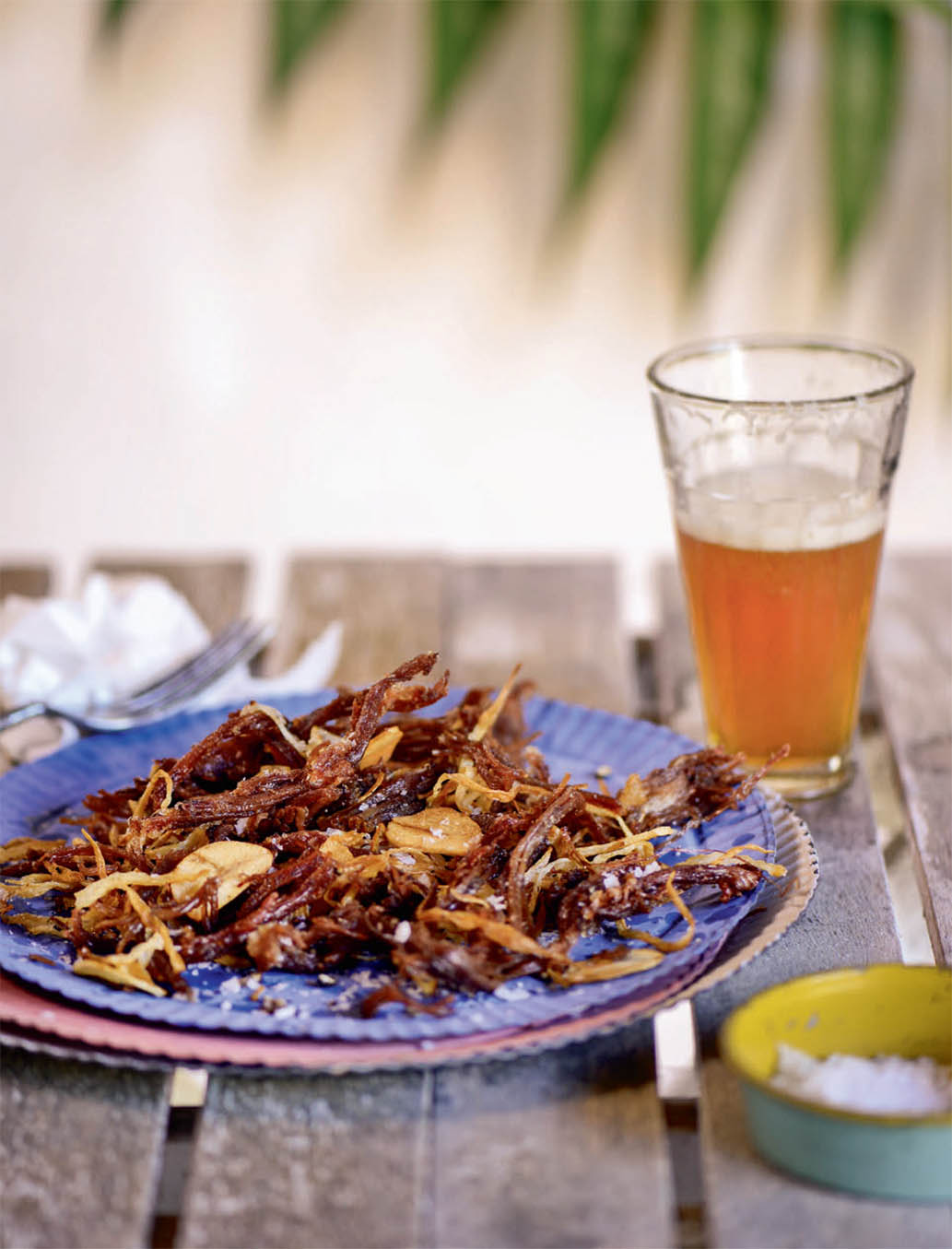
VACA FRITA
“FRIED COW”
YIELD: Serves 6 to 8
METHOD: Frying/sautéing
PREP TIME: 15 minutes (plus 1 hour for drying the beef in the refrigerator)
COOKING TIME: 2½ hours for boiling the brisket (see here), plus 6 to 9 minutes for frying
HEAT SOURCE: Stove
YOU’LL ALSO NEED: Meat claws (optional); a large skillet; a strainer
WHAT ELSE: There are two ways to crisp the brisket—by pan-frying or by deep-frying. The former is easier to execute in most kitchens, but if you’re comfortable with deep-frying, the resulting vaca frita will be even crispier.
Vaca frita (“fried cow”) is a Cuban delicacy, not to mention a close cousin of the Ropa Vieja. Both start with shredded, boiled brisket. But instead of simmering the brisket in Creole sauce as you do for the latter, in the former you fry the meat shreds in hot oil with onions and garlic. The finer you shred the brisket, the crispier the filaments of beef will be.
INGREDIENTS
2 pounds boiled brisket flat (see here)
1 cup vegetable oil, or as needed
1 medium onion, peeled and thinly sliced crosswise
3 cloves garlic, peeled and thinly sliced lengthwise
Sea salt and freshly ground black pepper
1. Tear the brisket into meaty shreds using meat claws, two forks, or your fingers. At a maximum, the shreds should be pencil-thick and about 3 inches long. If you have the patience, shred the meat as thin as spaghetti. Let the shredded brisket dry on a platter or wire rack set over a sheet pan in the refrigerator for 1 hour (drying makes it crispier and less likely to splatter when fried).
2. Set a large strainer over a bowl. Add the oil to a depth of ½ inch in a large skillet. Heat the oil over medium-high heat until a shred of brisket dipped in the oil has bubbles dancing around it.
3. Add a couple handfuls of brisket shreds to the oil and fry until crisp, 2 minutes. Transfer the meat with a skimmer to the strainer to drain. Repeat with the remaining brisket, working in batches to avoid crowding the pan. Fry the onions and garlic until browned and crisp, 1 to 2 minutes, and transfer to the strainer.
4. Transfer the fried brisket, onions, and garlic to a platter. Generously season with salt and pepper and serve.